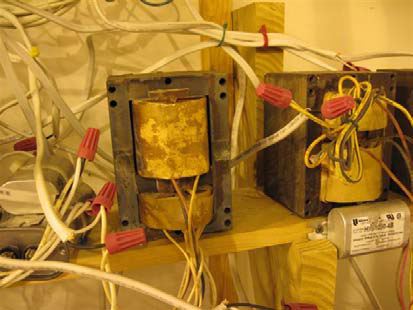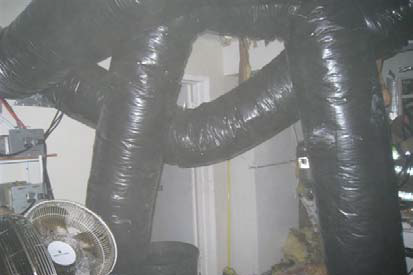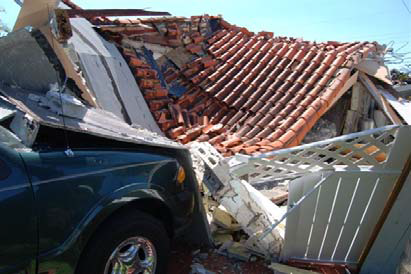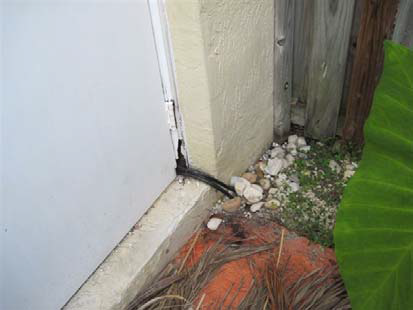
HAZARDS OF GROW HOUSES
The environment for growing marijuana indoors can be a very dangerous environment for firefighters when a fire occurs in a “grow house”. Growing operations are commonly filled with electric hazards due to exposed wiring, terminals and connections. Artificial light is created by high voltage mercury vapor or high pressure sodium lamps, each requiring its own igniter, capacitor and transformer (Photo 1).

Firefighters risk electrocution if they make bodily contact, contact with a metal tool or direct a stream of water on
this equipment at close range. The risk for electrocution is intensified when firefighters operate in limited visibility which will not be improved by a thermal imaging camera because the ceilings and walls are commonly covered with reflective insulation board. The reflective surface acts as a mirror when viewed through a thermal imager (Photo 2).
 DO NOT use steel New York roof hooks
DO NOT use steel New York roof hooksto pull ceilings in a grow house because you may make contact with energized wiring or equipment. All but the smallest growing operations require a substantial amount of electricity to illuminate the high intensity lights and run the air conditioners necessary to remove the excessive heat produced by the lights. Obtaining the power is commonly achieved by illegally and dangerously tapping into the electric service before the electric meter (Photo 3).


This diversion of the electrical service is usually connected to a separate electrical panel specifically for the grow operation (Photo 4).
The theft of electricity makes it almost impossible for firefighters to ensure that the power is secured.
Grow houses are extensively insulated to increase the efficiency of air conditioning and to reduce heat transfer to the upper floors and attic. Window openings are commonly covered by foilcovered insulation board. Several inches of insulation is necessary to prevent an unusually warm roof, indicative of a grow house, from being spotted by a helicopter infrared device (IRD). Extensive insulation and covered
exterior openings will hasten flashover conditions. Insulation overhead can mask indications of fire in the attic or in the space between the ceiling of the growing area and the floor above. Marijuana has a distinct, pungent odor which is readily detectable outside a grow house. To prevent detection, grow house operators use large carbon filters
to absorb odors and may seal roof soffit vents when ventilation ductwork terminates in the attic. Odor venting from turbines at or near the ridge of a roof is less likely to be noticed than if they vented from soffits. Similarly, it is not uncommon to route exhaust duct work into a toilet to vent marijuana odor up a plumbing stack penetrating the roof. Holes cut in floors for ductwork present a falling hazard for firefighters as well as a route for vertical extension. Firefighters operating in a smoky grow house also risk entanglement in electric wires, water tubing suspended from the ceiling, string used to support mature plants, and wire helix inside flexible ductwork (Photo 5).
Grow houses commonly have one or more pressurized gas cylinders which can explode if exposed to fire. Gas cylinders are used to enrich the concentration of carbon dioxide to hasten growth of the plants. This is achieved by releasing CO2 from a gas cylinder or producing it from a propanefueled carbon dioxide generator,

supplied by an LP cylinder. Increasing the level of CO2 can cause an oxygendeficient atmosphere. Firefighters
entering an enclosed space for growing must use their SCBA until the space is ventilated and metered for adequate oxygen concentration. An exploding LP cylinder inside a grow house in Miami- Dade County resulted in a partial collapse of the structure; fortunately the explosion occurred before the arrival of firefighters (Photo 6).

Booby traps, intended to thwart the theft of plants cannot distinguish between a burglar, a police officer or a firefighter. Booby traps are not common in this area but Miami-Dade Police officers did encounter a board with protruding nails on the floor inside the door of a grow house.
Although it is very difficult to identify a grow house from the outside, firefighters conducting a “360” size-up should suspect any unusual hoses or wires entering a building and report their presence to the Incident Commander. For example, police officers serving a
warrant at a suspected grow house by chance happened to notice something unusual about the house next door to
the suspected house: Two hoses from the swimming pool pump entered the house through a hole in an exterior wall. The officers suspected that the hoses were connected to a heat pump used to air condition a grow operation. Their suspicions were raised when they examined the other side of the house and found large gauge electric wires that evidently tapped into the underground electrical service before it entered the meter (Photo 7).

The first indication of a grow operation observed by firefighters operating in limited visibility may be a garden hose
leading to a large garbage can containing water and a submersible pump commonly used to water marijuana plants. Similarly, pumps, hoses or plastic containers in a bath tub or shower is also suspect. Window openings covered on the inside are usually concealed by blinds and impossible to detect, however

There is a significant civilian life hazard at many grow houses because a portion of a residence is used for growing, while the remainder is occupied by families with children. Unfortunately innocent children are at risk of being trapped by blocked doorways and covered windows due to their parent’s greed. Firefighters searching for occupants of a
suspected grow house should strongly consider vent, enter and search (VES) operations. This tactic involves breaking windows from the outside, completely removing the sash and any covering, making entry and searching the area near the window. VES allows rapid entry and search of bed rooms, which can be difficult to locate from the inside due to the due to a grow house’s make-shift partitions.
Firefighters place themselves at great risk when they enter a fire building without knowing its occupancy because they, literally, do not know what they’re getting into. Knowing a building’s occupancy or use gives firefighters a general idea of its floor plan and what hazards to expect. Firefighters are at greater risk, however when they enter a house thinking it is a residential occupancy and are not aware that it is used for a marijuana growing operation. Early recognition of a grow houses and awareness of their associated hazards are keys to reducing the risk to firefighters operating at fires in these dangerous and illegal occupancies.
Calendar
Sep 29-30, 2011 Intelligent Firefighting “Be Aggressive . ..Don’t Be Stupid”
With Capt Bill Gustin, Miami Dade Fire Rescue Double Tree Milwaukee City Center Milwaukee, Wisconsin
Sep 29-30, 2011 Intelligent Firefighting “Be Aggressive . ..Don’t Be Stupid”
With Capt Bill Gustin, Miami Dade Fire Rescue Double Tree Milwaukee City Center Milwaukee, Wisconsin
